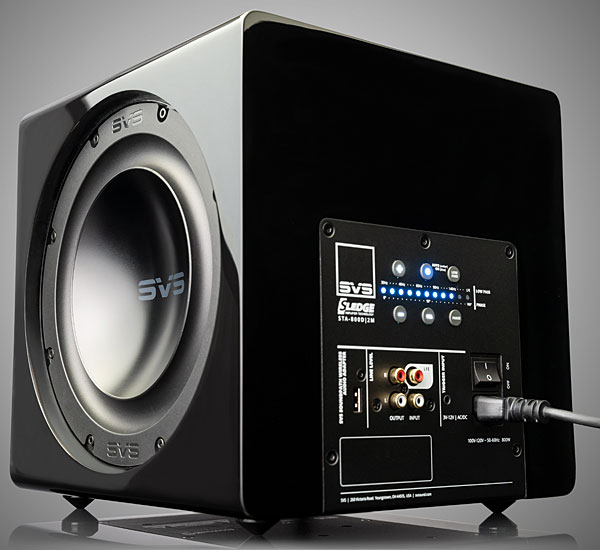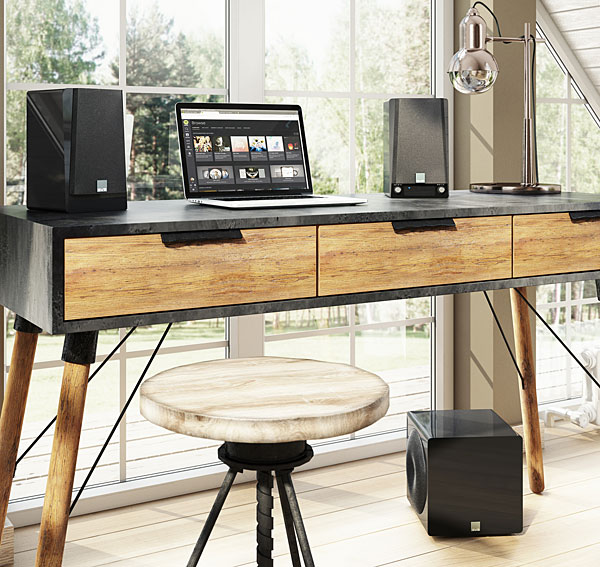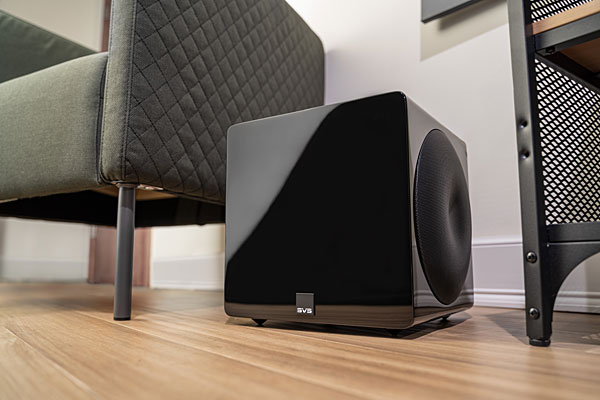SVS 3000 Micro Subwoofer Review Page 2
Next, up: How loud? My previous trials were just about as loud as I ever listen electively. But science demands more, so I powered down my left/right monitors and repeated the same track rotation, auditioning the subs "naked," while gradually increasing level. With about 6dB added, the little SVS was still fine—solidly pitch-defined and free of rude noises—as was, of course, the big SVS tube. So too was the KEF, though it was noticeably less loud, its DSP dynamic/equalization being activated as the electromechanical system approached its limits. At about 10dB louder than my original level the SVS evinced the same sort of limiting: it still sounded clean and musical, but essentially stopped responding to higher signal input, getting little if any louder. It also produced a noticeable "tup" on the leading edge of the strongest/lowest notes, which was not present at the lower levels. Presumably, this was a mechanical artifact of the sub's drivers and/or bass-dynamics brain probing their limits, though it was never audible in full-system listening at any level. The PC-12-Plus took the blue here, producing ridiculous bass levels, and simultaneously exciting many more previously unknown room rattles.

Now, the toughest test: How smooth? This is the hardest factor to judge by ear. We want a subwoofer's frequency response to be flat, or perhaps slightly falling smoothly from its crossover point down to its lower limit, which will make integrating any woofer with the rest of the system much simpler. The SVS 3000 Micro seemed to me to be admirably so. I had no difficulty matching it to my main monitors, and I heard no mid-bass emphasis or "extra" punch at any specific point over its useful range right down to 25Hz and a bit lower. But this is only one setup, one crossover point, and one set of speakers. And, at the risk of repeating myself: the room, the room, the room. Any sub may work better in one room and worse in another, where its own peak coincides with a strong acoustical mode. Still, the 3000 Micro impressed me as quite un-peaky—and the measured response curves SVS publishes for it support this—so I'd expect it to work easily over a range of rooms and systems.
The Extras
Subwoofers used to be essentially featureless, but not in the digital age. SVS, like many woofer-makers, has implemented DSP smarts—though not auto-EQ/room correction—into the 3000 Micro to enable a range of optimizations, all accessible via its free app. This is simple and cleanly designed, with a nice "Tutorial" tab that offers pop-up help for each feature (though it assumes understanding of basic terms like "phase" or "filter").
The app provides instant access to low-pass frequency and slope (6, 12, 18, or 24dB/octave), continuous-phase adjustment and polarity-inversion, and a range of equalization possibilities. These include three parametric bands of +6/-12dB, adjustable over the 3000 Micro's full 20-200Hz range, and with "Q" (bandwidth) infinitely adjustable from 10 (very narrow and steep, effectively a 1/6th-octave peak/dip), to 0.2 (very broad and gradual, effectively a shelving filter depending on frequency).

This is easily enough EQ to get us into trouble, and one band is all most rooms should require. You can effectively sit and listen to low-bass-rich music and slide a single high-Q filter cutting by, say, 6dB up and down in frequency, from the comfort of your listening chair until you find your room's principal mode. You'll know it when you find the frequency where bass suddenly sounds "tighter" or cleaner, but not significantly less strong or weighty. Pretty cool.
Equally useful is Room Gain Compensation, which offers a high-pass filter at your choice of 25, 31, or 40Hz, with your choice of 6 or 12dB/octave slopes, to counteract the "bass buildup" that occurs in many real-world rooms below the frequency related to the wavelength equivalent to the longest wall. Though there are many, many mitigating or exacerbating variables, for best accuracy the smaller the room the higher the frequency that should be applied. But as much as most of us love deep bass, many may just leave this off—I did! (To be fair, many A/V receivers offer an equivalent to one or both of the two features listed above.)
The handiest screen of all is "Home," which offers just a subwoofer volume slider providing 60dB of range below your setup reference plus a choice of four presets (Movie, Music, Custom, and Default, all rename-able). Each of these can store a custom combination of adjustments.

The Bear Facts
Clearly, the new SVS 3000 Micro subwoofer is neither too big nor too small. But is it just right? Pretty darned close. I found that it delivers more true deep bass, accurately, at greater levels, than any compact sub I've encountered. For most listening, in most rooms, it will be all the subwoofer you need. Will the 3000 Micro provide cinema-standard, reference-level bass underpinnings in a large home-theater? Almost certainly not: but I'll bet a pair, or a trio, or—hell, at $800 a pop why not?—a quartet would.
And that value factor is what makes the 3000 Micro a happy-medium bear. For similar money you can get slightly greater (maybe) extension, and rather greater output, in a much bigger package—from SVS among others. Alternately, you can get less extension, and rather less output, in an even smaller package. For my money, I'd prefer to split the difference with the Goldilocks of subwoofers, the SVS 3000 Micro.




























































